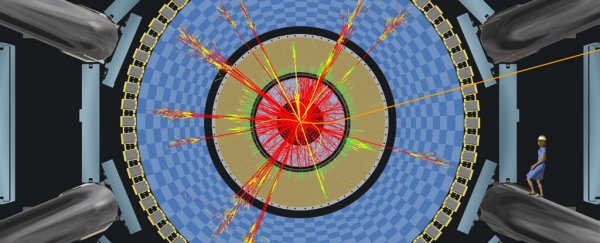Well, we called it earlier today, and now it's official. CERN has announced that, for the present at least, we haven't detected a brand new particle capable of breaking the Standard Model of particle physics.
If you've been following the story so far, you'll know that the news comes as a blow for many physicists who've spent the past seven months coming up with possible explanations for this new particle.
(And if you're playing along with our CERN announcement drinking game, you should have finished your glass by now).
CERN made the announcement this morning at the International Conference of High Energy Physics (ICHEP) in Chicago, alongside a huge slew of new Large Hadron Collider (LHC) data.
"The intriguing hint of a possible resonance at 750 GeV decaying into photon pairs, which caused considerable interest from the 2015 data, has not reappeared in the much larger 2016 data set and thus appears to be a statistical fluctuation," CERN announced in a press release sent via email.
Why did we ever think we'd found a new particle in the first place?
Back in December, researchers at CERN's CMS and ATLAS experiments smashed particles together at incredibly high energies, sending subatomic particles flying out as debris.
Among that debris, the researchers saw an unexpected blip of energy in form of an excess in pairs of photons, which had a combined energy of 750 gigaelectron volts (GeV).
The result lead to hundreds of journal article submissions on the mysterious energy signature - and prompted many physicists to hypothesise that the excess was a sign of a brand new fundamental particle, six times more massive than the Higgs boson - one that wasn't predicted by the Standard Model of particle physics.
But, alas, the latest data collected by the LHC shows no evidence that this particle exists - despite further experiments, no sign of this 750 GeV bump has emerged since the original reading.
So, we're no closer to finding a new particle - or evidence of a new model that could explain some of the more mysterious aspects of the Universe, such as how gravity works (something the Standard Model doesn't account for).
But it's not all bad news.
CERN researchers also announced that the LHC is now at peak luminosity - which means it's performing around 1 billion high-energy particle collisions per second, "so that even the rarest processes at the highest effective energy could occur".
It's also running at record-breaking energy levels of 13 trillion electronvolts (TeV).
Because of this, the LHC has already recorded five times more data in 2016 than it did in all of 2015, despite only running for a few months this year. Amongst those data is even more verification for the Higgs boson.
In other words, we may not have found any new particles just yet, but if they're out there, it's only a matter of time, because the LHC is running bigger and better than ever before.
"This is one of the most exciting times in recent years for physicists, as we dig into the unknown in earnest: the particle physics at an energy never explored before," said CERN Director for Research and Computing, Eckhard Elsen.
If you're really keen, you can start wading through some of the LHC results yourself to look for signs of new physics - the ATLAS experiment just released the data from 100 trillion proton collisions from 2012 to the public.
Happy hunting.
